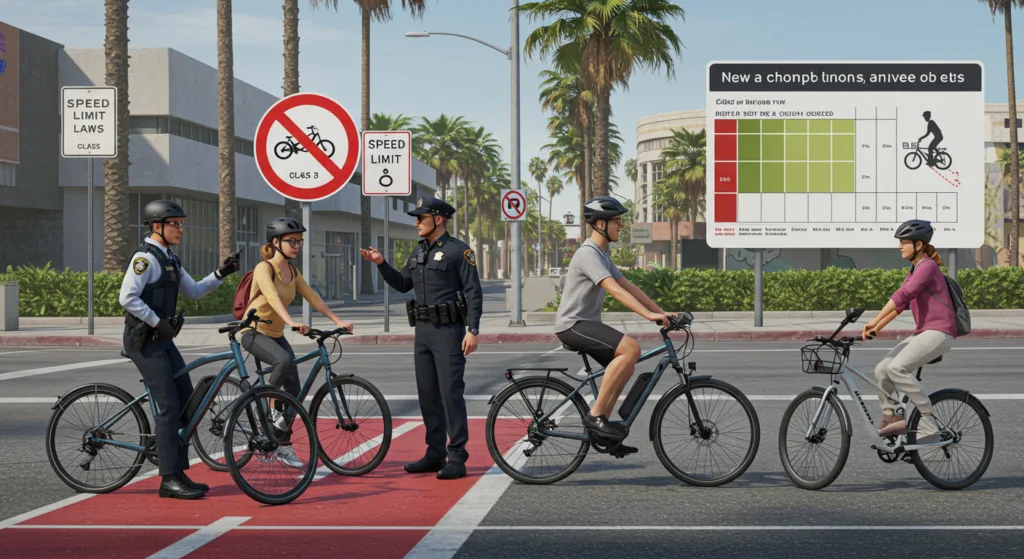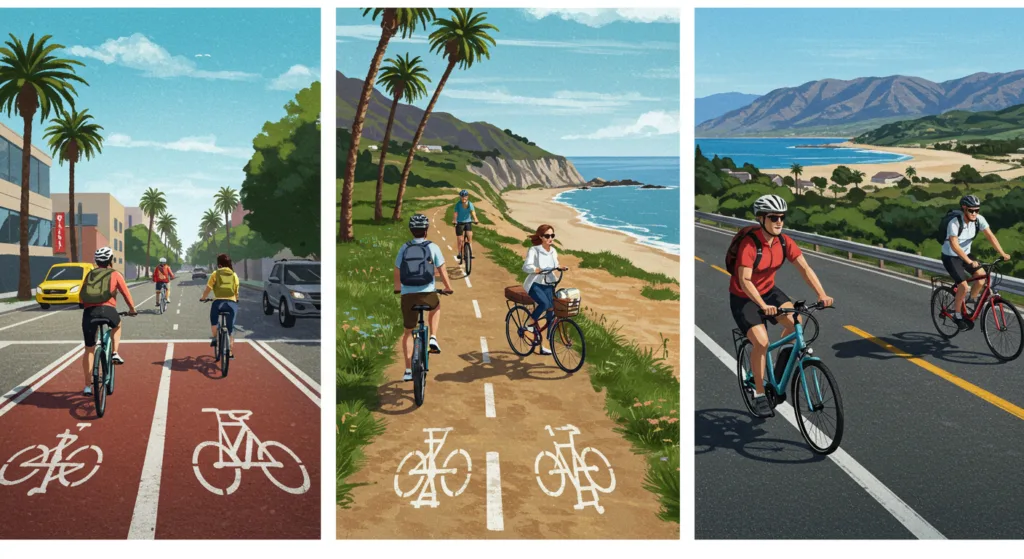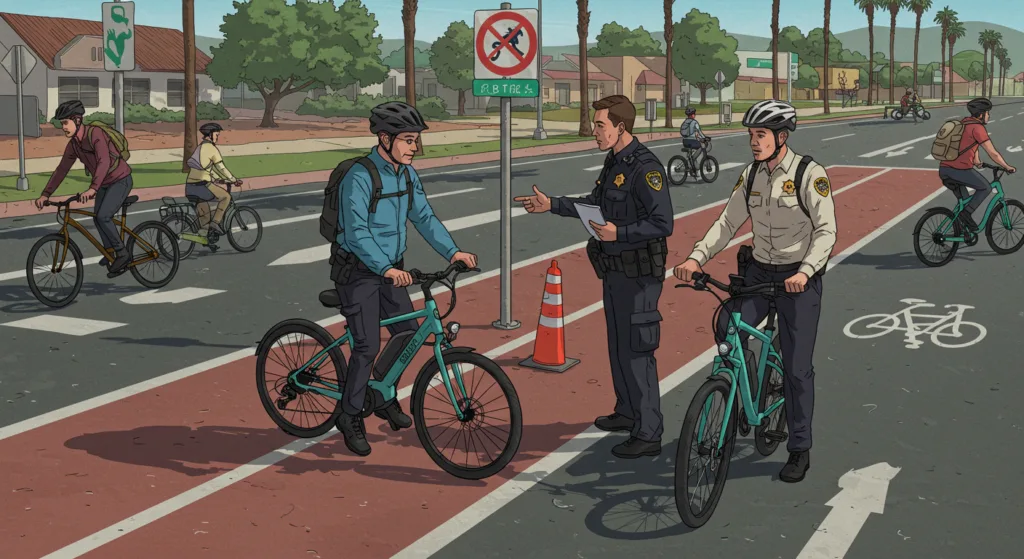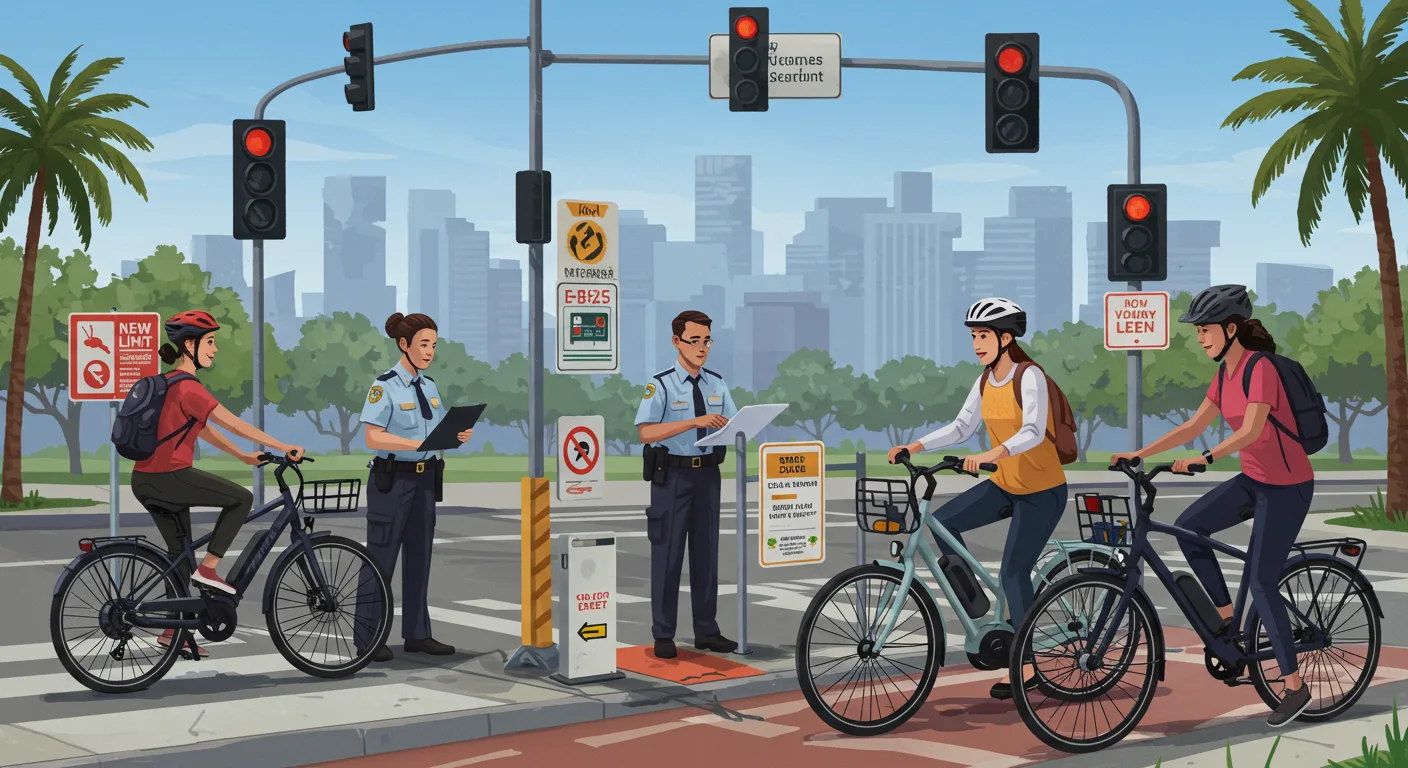Are Electric Bike Rules Changing in California in 2025?

Yes, significant changes to California eBike laws are set to take effect in 2025. These updates aim to enhance rider safety, clarify eBike classifications, and ensure that electric bicycles operate within defined parameters. Understanding these changes is crucial for all eBike enthusiasts to remain compliant and safe on the roads.
New Speed Limits & Classification Rules Explained
California’s eBike classification system divides electric bicycles into three categories:
- Class 1 eBikes: Pedal-assist only, with motor assistance up to 20 mph.
- Class 2 eBikes: Equipped with a throttle, allowing motor-powered speeds up to 20 mph without pedaling.
- Class 3 eBikes: Pedal-assist only, with motor assistance up to 28 mph.
The 2025 legislation introduces specific modifications to these classes:
- Throttle Restrictions: Class 1 and Class 3 eBikes are now required to be exclusively pedal-assist, prohibiting the use of throttles. Class 2 eBikes retain throttle capabilities but are limited to motor-powered speeds of 20 mph.
- Motor Power Cap: All eBikes must have motors with a maximum output of 750 watts. Exceeding this limit reclassifies the eBike as a motor vehicle, subjecting it to additional regulations.
- Pedal Requirement: To maintain eBike classification, bicycles must have operable pedals. Removing pedals or modifying the bike to function without them will result in reclassification as a motor vehicle.
These measures aim to ensure that eBikes remain distinct from electric motorcycles and other motorized vehicles, promoting safety and regulatory clarity.
How 2025 Law Updates Affect eBike Riders
The upcoming legal adjustments will have several implications for eBike riders in California:
- Modification Limitations: Altering an eBike to exceed speed or power limits will lead to its reclassification as a motor vehicle, necessitating registration, licensing, and insurance.
- Battery and Safety Standards: Starting January 1, 2026, all eBike batteries must undergo safety testing by accredited laboratories. Manufacturers are required to display certification labels, and charging systems must be certified for specific bike models.
- Helmet and Age Requirements: Riders under 18 must wear helmets on any eBike. For Class 3 eBikes, all riders, regardless of age, are required to wear helmets. Additionally, operating a Class 3 eBike requires a minimum age of 16.
- Access Restrictions: Class 3 eBikes are generally prohibited from bike paths or trails unless local ordinances permit their use. Riders should consult local regulations to ensure compliance.
These changes underscore the importance of staying informed about local laws and ensuring that eBikes meet the specified criteria to avoid potential fines or legal issues.
As eBikes continue to gain popularity as a sustainable transportation option, adhering to these updated regulations will help integrate them safely into California’s transportation ecosystem.
Where Can You Ride an eBike in California?

Navigating the diverse landscapes of California on an electric bike (eBike) offers both excitement and convenience. However, understanding California eBike Laws and where you can legally ride your eBike is essential to ensure compliance with state and local regulations. The rules vary based on the classification of your eBike and specific local ordinances.
eBike Access on Bike Lanes, Roads & Trails
California classifies eBikes into three categories, each with distinct regulations regarding their operation on bike lanes, roads, and trails:
- Class 1 eBikes: These pedal-assist bikes provide motor assistance only when the rider is pedaling, ceasing assistance at 20 mph. Riders can operate Class 1 eBikes on:
- Bike Lanes (Class 2 Bikeways): Designated lanes on roadways marked for bicycle use.
- Multi-Use Trails (Class 1 Bikeways): Paved paths separated from motor vehicle traffic, shared with pedestrians.
- Roads: Streets and highways where bicycles are permitted.
- Class 2 eBikes: Equipped with a throttle, these bikes can propel without pedaling, with motor assistance up to 20 mph. Class 2 eBikes are allowed on:
- Bike Lanes (Class 2 Bikeways): Providing a designated space on roadways for bicycles and eBikes.
- Multi-Use Trails (Class 1 Bikeways): Unless local laws prohibit their use.
- Roads: Where bicycles are permitted.
- Class 3 eBikes: These pedal-assist bikes offer assistance up to 28 mph and are intended for more experienced riders. Regulations for Class 3 eBikes include:
- Bike Lanes (Class 2 Bikeways): Permitted on roadways, excluding those designated exclusively for Class 1 and 2 eBikes.
- Roads: Allowed where bicycles are authorized.
Reminder: Class 3 electric bikes are generally not allowed on multi-use trails unless explicitly permitted by local regulations—stick to designated bike lanes and roadways for a hassle-free ride! 🚴♂️⚡
Can You Ride an eBike on Sidewalks in 2025?
In California, riding eBikes on sidewalks is generally prohibited to ensure pedestrian safety. This restriction applies to all classes of eBikes. However, local ordinances can vary:
- Prohibited Areas: Many cities and counties have enacted laws forbidding eBikes on sidewalks. For instance, the City of Chino Hills has implemented regulations prohibiting eBikes and motorized scooters on public sidewalks, with fines ranging from $100 for the first offense up to $500 for repeated violations.
- Exceptions: Some municipalities may allow eBikes on sidewalks in specific areas, such as when the adjacent roadway has high-speed limits or lacks bike lanes. It’s crucial to consult local laws to determine permissible areas for sidewalk riding.
To avoid penalties and ensure the safety of all road and pathway users, eBike riders should familiarize themselves with both state laws and local ordinances. Staying informed and adhering to designated riding areas will contribute to a harmonious coexistence between eBike riders, pedestrians, and motorists across California.
Do You Need a License or Insurance for an Electric Bicycle?

As electric bikes (eBikes) become increasingly popular in California, understanding California eBike Laws regarding licensing, registration, and insurance is essential for both current and prospective riders. The state’s regulations aim to balance rider freedom with safety considerations, and recent legislative updates have introduced specific changes effective from January 1, 2025.
Quote: “Ride smart, ride legal—knowing your e-bike’s classification keeps you on the right side of the law.”
California’s eBike Registration & Licensing Rules
In California, eBikes are categorized into three classes, each with distinct regulations:
- Class 1 eBikes: Pedal-assist only, with motor assistance up to 20 mph.
- Class 2 eBikes: Equipped with a throttle, allowing motor-powered speeds up to 20 mph without pedaling.
- Class 3 eBikes: Pedal-assist only, with motor assistance up to 28 mph.
As of 2025, California law does not require operators of Class 1, Class 2, or Class 3 eBikes to obtain a driver’s license or register their eBikes with the Department of Motor Vehicles (DMV). These eBikes are treated similarly to traditional bicycles concerning licensing and registration. However, it’s crucial to ensure that your eBike complies with the state’s specifications:
- Motor Power Limit: The motor must not exceed 750 watts. E-Bikes with motors exceeding this limit are reclassified and subject to different regulations.
- Speed Capabilities: Class 1 and Class 2 eBikes should not provide assistance above 20 mph, while Class 3 eBikes can assist up to 28 mph. Modifying an eBike to exceed these speeds can lead to reclassification, necessitating registration and licensing akin to motor vehicles.
It’s important to note that local jurisdictions may impose additional regulations, so always verify any city or county-specific rules that might affect your eBike usage.
Do You Need Insurance for an eBike in 2025?
Currently, California does not mandate insurance for eBike riders across Class 1, Class 2, or Class 3 categories. However, considering the potential risks and the investment involved in owning an eBike, obtaining insurance is advisable. Insurance can provide coverage for:
- Theft or Vandalism: Protects against financial loss if your eBike is stolen or damaged maliciously.
- Accidental Damage: Covers repair costs resulting from collisions or accidents.
- Liability: Offers protection in case you’re involved in an accident that causes injury to others or damages property.
Several insurance providers offer policies tailored specifically for eBikes. For instance, BikeInsure provides plans that include physical damage coverage with a $100 deductible and optional theft protection with a $250 deductible.
While homeowners or renters insurance policies might offer some coverage for personal property, they often come with high deductibles and may not cover incidents occurring outside the home. Therefore, specialized eBike insurance can offer more comprehensive protection suited to your riding habits.
In summary, while licensing and registration are not required for standard eBikes in California as of 2025, securing insurance is a prudent step to safeguard your investment and ensure peace of mind while riding. Always stay informed about any changes in local laws and consider consulting with insurance professionals to find a policy that best fits your needs.
Understanding California electric bicycle laws is crucial for staying compliant and enjoying a safe ride in 2025. With updates to speed limits, classification rules, and riding regulations, eBike riders must stay informed to avoid fines and restrictions. Whether you’re commuting, exploring trails, or considering eBike insurance, these legal changes impact your experience.
If you found this guide helpful, share it on social media to help fellow riders stay updated on the latest eBike laws in California! 🚴⚡



